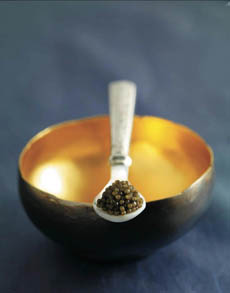NEWS: Russian Caviar Is Back
 Fine sturgeon caviar: so pricey, yet to those who love it, so wonderful. Photo courtesy Petrossian. |
Following a decade long prohibition on importing Russian caviar to the U.S.—due to damming, overfishing and pollution in the Caspian sea—those with the desire and the coin can have it again.
A bit of history: CITES, the United Nations’ Convention on International Trade in Endangered Species, aims to protect wildlife against over-exploitation, and to prevent international trade from threatening species.* In 2001, CITES responded to high levels of poaching and illegal trade in caviar by halting the caviar trade by Azerbaijan, Kazakhstan, Russia and Turkmenistan. It proposed the ban on exporting Caspian caviar by the Russian states that border the Caspian Sea. The U.S. supported the treaty. Since then, the harvesting of Osetra sturgeon caviar has moved from their native Caspian Sea to farms built in rivers around the world—in China, Italy, Israel, Uraguay and the United States, among others. Those who want fine sturgeon caviar have no problem buying it; and those who purchase it find it an even switch for the Russian Osetra. Russia, too, has taken up sustainable river farming of sturgeon; and this caviar is now authorized by CITES for export. |
|
|
*CITES (the Convention of International Trade in Endangered Species of Wild Life Fauna and Flora), created in 1973, is an international concurrence between governments. It is placed to ensure that the international trade in specimens of wild animals and plants does not threaten their survival. CITES is an international agreement in which countries adhere voluntarily. With now 180 parties, CITES is among the conservation agreements with the largest membership. Black Caviar Company has announced an exclusive partnership with Russian Caviar House to import of CITES certified Russian osetra sturgeon caviar into the U.S. It joins the other farmed sturgeon caviars that have been available since the ban. DEEP POCKETS REQUIRED If you want to try black sturgeon caviar, you can buy it, and ideally compare it to a product from another origin (we’re partial to the Transmontanus caviar, farmed in the U.S., that you can buy from Petrossian and elsewhere). Black Caviar Company sells it for prices comparable to other fine, farmed sturgeon caviar: Check out the different types of caviar. |
||



